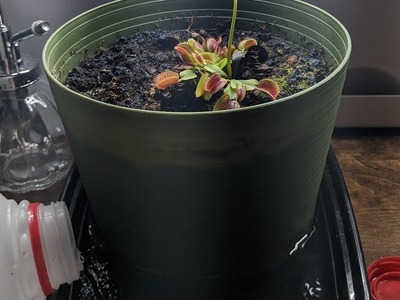Using the correct water for your Venus fly trap is critical to keep the plant healthy and alive. Some water will harm Venus fly trap while other is entirely safe, and all has to do with the mineral content. In this article, I share what water is safe, how to obtain it, and general tips.
Venus fly traps need pure water, such as distilled, reverse osmosis or rainwater. Minerals present in most tap water, bottled water, and spring water are very harmful to Venus fly traps.
The following table lists different types of water and whether they are suitable for carnivorous plants. Keep reading to learn more about each and where to obtain water for your plant.
| Water Type | Is this water safe for Venus Fly Traps? |
| Distilled water | Yes |
| Reverse osmosis water | Yes |
| Rainwater | Yes |
| Tap water | Sometimes (depending on the composition) |
| Bottled water | No |
| Boiled water | No |
| Purified water | No |
| Filtered water | No (except when using the ZeroWater filter properly) |
| Spring water | No |
Why do Venus fly trap need special water?
Venus fly trap grow in very poor soil that lacks nutrients. Due to the challenging conditions surrounding them in the wild, these plants developed a trapping mechanism to capture bugs and extract critical nutrients. Also, they developed an intolerance to nutrients. Minerals in most water affect venus fly traps as they prefer pure water without any nutrients.
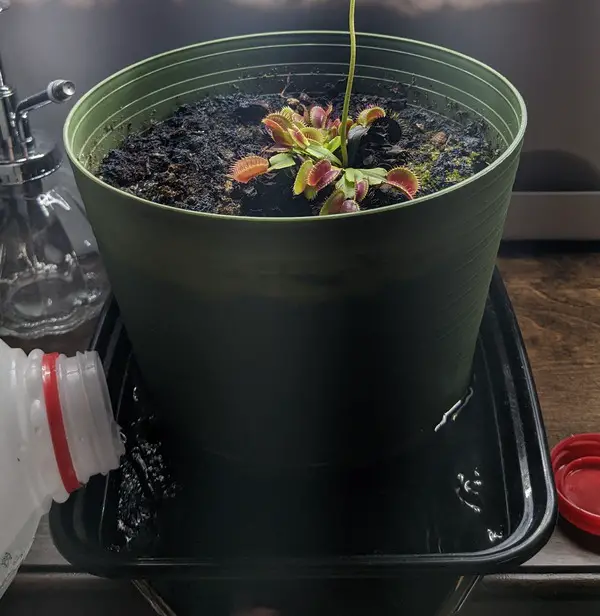
Water VFTs only with:
Distilled water
Reverse Osmosis water or
Rainwater
The Best Water for Venus Fly Trap
Venus flytraps are very sensitive to minerals and additives from most water. As a general rule, you should try to only water your plant with pure mineral-free, electrolyte-free water. These are some alternatives:
- Distilled water
- Reverse osmosis water
- Rainwater
- Filtered water with ZeroWater filter
Distilled Water
Where to purchase: grocery store, pharmacy, water store
How to make: You can follow this easy method to make distilled water at home.
How to shop for distilled water: Most grocery chains and pharmacies sell plain distilled water. I usually buy the 1-gallon jugs labeled as distilled water in Walmart or Kroger. When selecting a jug of distilled water, read the label. The filtered water must be completely pure. If the bottle says something like “enriched,” “added mineral for flavor,” or “minerals,” then it is not pure and can kill your Venus fly trap.
This distilled water is safe for Venus fly traps.

Reverse Osmosis Water
Where to purchase: Water stores and some pharmacies will carry RO water.
How to make: You need to have a reverse osmosis system to make RO water
How to select: make sure to ask for pure reverse osmosis water. It is helpful to ask if it has additives or minerals for taste. The answer to all those questions should be “No.” Bottled water is commonly purified through reverse osmosis, but minerals are added. For that reason, most bottled RO water is unsafe for Venus fly traps.
Rainwater
Rainwater is the only free option available if you have access to enough rain throughout the year. If you collect rain, do not store it in clay or metal containers. Those materials can leach minerals to the ground.
Filtered Water
Filtered water can be appropriate for a Venus fly trap, depending on what water you are filtering and the water filter you use. I have tried a few, and the only one that met the specs was Zero water. Zero Water filters remove all particles from the water and output 0 parts per million (ppm) water, which is optimal for carnivorous plants.
You check out the specs and price of the zero-water filter here (the link will take you to Amazon.com). I have used it successfully for my plants without any issues, you need to change the filter once it reaches its limit and the filtration efficiency decreases.
The ZeroWater filter was the only one that reduced the ppm measurement enough to make the water safe for carnivorous plants. If the tap water in your home is close to pure, then the Brita and PUR filters might be suitable. But you will have to verify by using a TDS meter to measure it. A TDS meter is straightforward and helps you measure the ppm content; if it is under 50ppm, you are safe. You can buy any TDS meter like this one for under $20 and ensure your plant is healthy.
Water That Kills Venus Fly Trap
The minerals and additives present in most water will kill Venus fly traps.
Venus fly traps are intolerant to nutrients, and any additives in the water will slowly poison them.
NEVER employ this water for your Venus fly trap:
- Bottled water
- Spring water
- Sea water
- Tap water
- Boiled water
On some specific occasions, bottled water or tap water could be pure enough for carnivorous plants. However, it is impossible to determine this by tasting it or reading the label.
You will need a TDS meter to measure the number of dissolved solids in the water. Testing the water with a TDS meter takes only a few seconds.
Generally, water of 50 parts per million (ppm) or less is safe for Venus flytrap. Anything above can produce mineral buildup and cause mineral burns. Optimally, you should try to use water of 0 ppm to avoid all minerals.
This is me testing the tap water at home. The ppm measure is way above 50 ppm and, therefore, unsafe for the Venus fly trap. I also tried some bottled water.
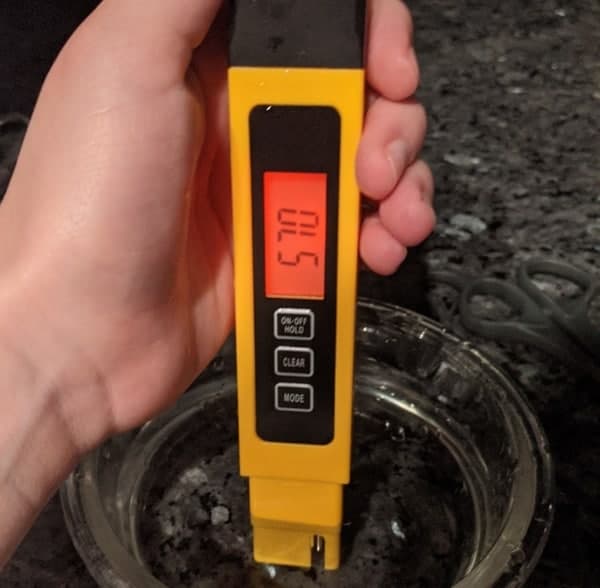
Not all bottled water will be the same. However, the vast majority won’t be 100% pure. Most drinking water contains additives for taste and electrolytes that harm carnivorous plants.
Smart Water does not have a lot of additives. The ppm measure is close to 20 ppm, which is not optimal for a Venus fly trap, but within the acceptable range.
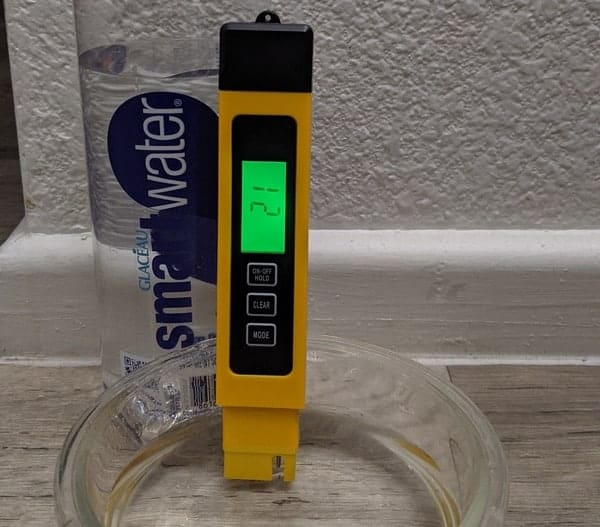
How to Water a Venus Fly Trap
Venus flytraps are native to the Carolinas in the United States. In the wild, they live in high humidity levels year-round and plenty of rainfall. When growing Venus flytraps at home, you must try replicating its native habitat, including the watering frequency.
Venus flytraps must be watered often until the soil is humid. Then, once the soil is slightly less humid, water again. Never allow the soil to dry out completely; Venus fly traps suffer in dry ground.
After watering a Venus flytrap, you should be able to press the soil and sense the humidity throughout without it being soaked. If the soil feels muddy, you watered too much. If the soil is still dry, water again.
Overwatering and underwatering Venus flytraps are dangerous for the health of the plant. However, underwatering is a lot more common.
Most people will water Venus fly trap every 2 to 3 days. However, the specific watering frequency varies significantly with different environmental conditions.
I live in an area with extremely hot summers (110 F+). During the summer months, I water my plants almost every day. But, in mild weather or indoors, you might only need to water your plant several times a week.
During winter, you will also need to lower the watering frequency.
This article can guide you and teach you how to determine how much water your plant needs. Also, it can help you examine if your plant might be under or over-watered: How often to water Venus fly trap to keep them alive.
How to water a Venus Fly trap 101
- Only use pure-water: distilled, reverse osmosis or rainwater
- Avoid tap water or bottled water at all costs
- Water often to keep the soil humid
- Never let the soil dry out
- Do not flood the soil. Venus fly traps are not bog plants.
- Decrease watering if algae or mold appear
- Lower watering during dormancy
- Consider watering your plant with the very effective tray method
Should Venus Fly Trap Sit In Water
Placing Venus flytraps in trays of water is a common practice to water a Venus fly trap.
Venus flytraps require humid soil at all times, which is hard to accomplish by simply watering every few days.
Even though leaving Venus fly trap sitting in water is a common and acceptable practice, it shouldn’t be done for extensive periods.
Venus flytraps can sit in water for short periods, but they should not sit there for multiple days. Place the Venus fly trap in a tray with a water depth of 1-2 inches. Then, wait until the water is consumed before refilling.
When you let Venus flytraps sit in water, you water the plant from the bottom. The potting media is slowly soaking the moisture, and the roots strengthen to reach the bottom of the pot and have access to water.
This is how you water your plant from the bottom:
- Gather your Venus flytrap in its pot, a gallon of distilled water ( you can employ rainwater or reverse osmosis water, too), and a shallow tray big enough to fit the plant’s pot.
- Place the plant pot on top of the shallow tray.
- Pour the pure water into the tray. Fill up the trap until the water is 1 inch deep.
- Do not water again until the tray has dried up. Then, fill up the tray again to reach a maximum of one inch.
- Repeat the process.
The tray does not need to be anything fancy. Any container will be appropriate. For this plant, I reused a plastic container filled with water every few days.
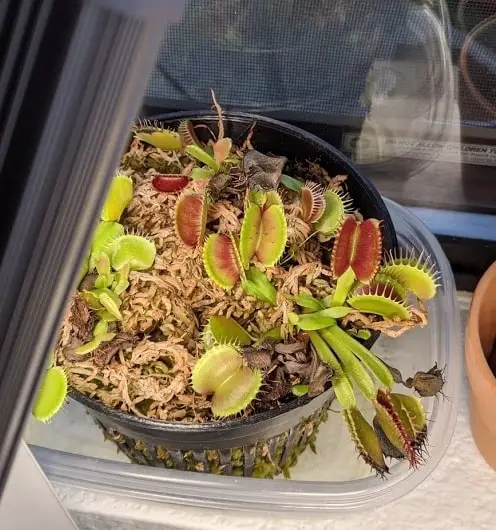
Watering your plant from the bottom offesignificanteat benefits. You can read this article to go over step by step and determine how much water your Venus fly trap needs and how to accomplish it.


